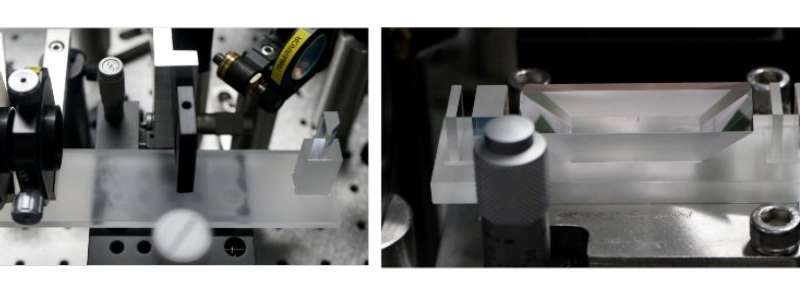
Photos of the experimental setup. Credit: Wang et al. ©2018 American Physical Society
Physicists have experimentally demonstrated 18-qubit entanglement, which is the largest entangled state achieved so far with individual control of each qubit. As each qubit has two possible values, the 18 qubits can generate a total of 218 (or 262,144) combinations of output states. Since quantum information can be encoded in these states, the results have potential applications anywhere quantum information processing is used.
The physicists, Xi-Lin Wang and coauthors at the University of Science and Technology of China, have published a paper on the new entanglement record in a recent issue of Physical Review Letters.
"Our paper reports 18-qubit entanglement that expands an effective Hilbert space to 262,144 dimensions (the largest so far) with full control of three degrees of freedom of six individual photons, including their paths, polarization, and orbital angular momentum," coauthor Chao-Yang Lu at the University of Science and Technology of China told Phys.org. "This represents the largest entanglement so far. Entangling an increasingly large number of qubits not only is of fundamental interest (i.e., pushing the physical limit, if there is one, in order to explore the boundary between quantum and classical, for example). But also, probably more importantly, entangling large numbers of qubits is the central task in quantum computation."
Generally, there are two ways to increase the number of effective qubits in an entangled state: use more particles, or exploit the particles' additional degrees of freedom (DoFs). When exploiting multiple DoFs, the entanglement is called "hyper-entanglement." So far, some of the largest entangled states have included 14 trapped ions with a single DoF, and five photons with two DoFs (which is equivalent to 10-qubit entanglement).
Although going beyond two DoFs presents greater technological challenges, in the new study the physicists developed new methods to generate scalable hyper-entanglement, producing an 18-qubit entangled state made from six photons with three DoFs.
"Controlling multiple DoFs is tricky, as it is necessary to touch one without disturbing any other," Lu explained. "To solve this, we develop methods for reversible quantum logic operations between the photon's different DoFs with precision and efficiencies both close to unity. We believe that our work creates a new and versatile platform for multi-photon quantum information processing with multiple DoFs."
Using additional DoFs has several advantages. For one, exploiting three DoFs instead of two doubles the information-carrying capacity of each photon from four to eight possible output states. In addition, a hyper-entangled 18-qubit state that exploits three DoFs is approximately 13 orders of magnitude more efficient than an 18-qubit state composed of 18 photons with a single DoF.
With these advantages, the physicists expect that the ability to achieve 18-qubit hyper-entanglement will lead to previously unprecedented areas of research, such as experimentally realizing certain codes for quantum computing, implementing quantum teleportation of high-dimensional quantum states, and enabling more extreme violations of local realism.
"Our work has created a new platform for optical quantum information processing with multiple DoFs," Lu said. "The ability to coherently control 18 qubits enables experimental access to previously unexplored regimes, for example, the realization of the surface code and the Raussendorf-Harrington-Goyal code for quantum error correction, and the teleportation of three DoFs of a single photon."
https://phys.org/news/2018-07-qubit-entanglement.html